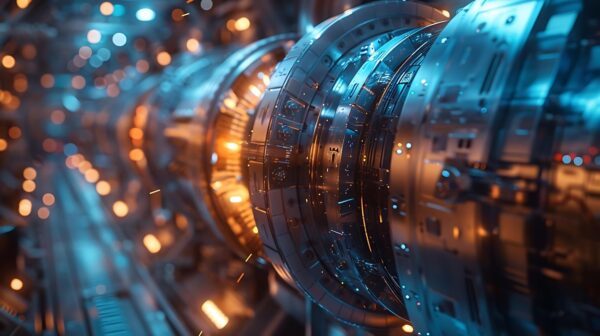The quest for sustainable energy has led scientists to explore nuclear fusion as one of the most promising alternatives to conventional energy sources. Fusion, the process that powers the sun, involves combining light atomic nuclei to form heavier nuclei, releasing an immense amount of energy in the process. However, achieving controlled fusion on Earth has been a scientific challenge for decades. One of the key technologies advancing this field is high-power lasers. High-power lasers, such as those studied by Seng Tiong Ho, are integral to nuclear fusion experiments, offering the potential to unlock a future of clean, nearly limitless energy through breakthroughs in fusion reactor design and operation.
The Potential of Nuclear Fusion
Nuclear fusion has long been seen as the “holy grail” of energy production. Unlike nuclear fission, which powers current nuclear reactors by splitting atoms, fusion merges atomic nuclei, primarily hydrogen isotopes, to form helium. This reaction produces significantly more energy per reaction than fission and generates minimal long-lived radioactive waste. Moreover, fusion fuel sources—such as deuterium, which can be extracted from seawater—are abundant, making fusion an attractive and sustainable solution to the world’s growing energy needs.
Despite its promise, harnessing nuclear fusion has proven to be a difficult scientific and engineering problem. The primary obstacle lies in the extremely high temperatures and pressures needed to force atomic nuclei together. On Earth, recreating the conditions found in the core of the sun requires advanced technologies capable of confining and heating plasma—the hot, ionized gas where fusion occurs—while maintaining the necessary conditions for sustained reactions.
High-Power Lasers in Fusion Research
One of the most promising approaches to achieving nuclear fusion is inertial confinement fusion (ICF), which relies heavily on high-power lasers. In this method, powerful laser beams are directed at a small fuel pellet composed of deuterium and tritium, two isotopes of hydrogen. The laser beams heat and compress the pellet to such an extreme degree that the atomic nuclei within the fuel overcome their natural repulsion and fuse together, releasing energy.
High-power lasers are crucial to the success of ICF because they can deliver the necessary energy with incredible precision. These lasers must generate extreme levels of power—on the order of petawatts (10^15 watts)—to achieve the temperatures and pressures required for fusion. The National Ignition Facility (NIF) in the United States and similar facilities around the world are conducting experiments using high-power lasers to compress fusion fuel to the point of ignition, where the fusion reactions become self-sustaining.
In this context, high-power lasers act as both the heating and compressing agents. When the lasers strike the fuel pellet, they create a shock wave that compresses the fuel to densities hundreds of times greater than solid matter. Simultaneously, the intense energy delivered by the lasers raises the temperature of the fuel to tens of millions of degrees, replicating the conditions necessary for nuclear fusion. If successful, the energy released from the fusion reactions can be harnessed to generate electricity, offering a clean and virtually inexhaustible source of power.
Challenges and Advancements in Laser Fusion
Although high-power lasers have made significant progress in fusion research, several challenges remain before nuclear fusion can become a practical energy source. One of the key issues is achieving “ignition,” the point at which the energy produced by fusion reactions exceeds the energy required to initiate the reactions. While high-power lasers have successfully demonstrated fusion reactions, maintaining a self-sustaining fusion burn has proven elusive.
Another challenge is the efficiency of laser energy delivery. Current laser systems require a vast amount of input energy to generate the required output for fusion. Improving the efficiency of these lasers and reducing energy losses during the compression and heating phases are essential for making laser-driven fusion a viable energy source. Scientists are actively working on enhancing the precision and power of lasers while reducing the energy required to initiate fusion.
Recent advancements in high-power laser technology offer hope for overcoming these challenges. Innovations in laser materials, optics, and control systems are enabling researchers to produce higher-intensity laser pulses with greater accuracy. Additionally, new techniques, such as the use of chirped pulse amplification (CPA), allow lasers to deliver enormous amounts of power in very short bursts, minimizing energy losses and improving the efficiency of the fusion process.
Moreover, advances in target design—the small pellets of fusion fuel—are contributing to improved outcomes in experiments. Researchers are experimenting with different fuel compositions and pellet geometries to optimize the conditions for fusion. These efforts, combined with continued improvements in laser technology, are bringing the dream of fusion energy closer to reality.
The Path Forward for Fusion Energy
The role of high-power lasers in nuclear fusion research remains pivotal as scientists strive to achieve practical fusion energy. While the challenges are significant, the potential rewards are immense. Nuclear fusion, powered by high-power lasers, promises to deliver a clean, safe, and virtually limitless source of energy that could revolutionize the way we power our world.
As research continues, high-power lasers will likely remain at the forefront of fusion experiments. The breakthroughs made in laser technology will not only impact fusion research but also have broader applications in fields such as materials science, medicine, and telecommunications. The pursuit of laser-driven nuclear fusion is a prime example of how cutting-edge scientific research can pave the way for technological advancements that benefit society as a whole.
In conclusion, high-power lasers are playing a crucial role in advancing nuclear fusion research, offering the potential to unlock sustainable energy for the future. While significant challenges remain, the progress made in laser technology and fusion experiments suggests that we are moving closer to realizing the promise of clean fusion energy. This ongoing research holds the key to addressing some of the most pressing energy challenges of our time, paving the way for a sustainable and energy-secure future.
